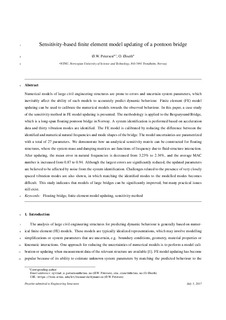Sensitivity-based finite element model updating of a pontoon bridge
Journal article
Submitted version
Permanent lenke
http://hdl.handle.net/11250/2462719Utgivelsesdato
2017Metadata
Vis full innførselSamlinger
Sammendrag
Numerical models of large civil engineering structures are prone to errors and uncertain system parameters, which inevitably affect the ability of such models to accurately predict dynamic behavior. Finite element (FE) model updating can be used to calibrate the numerical models towards the observed behavior. In this paper, a case study of the sensitivity method in FE model updating is presented. The methodology is applied to the Bergsøysund Bridge, which is a long-span floating pontoon bridge in Norway. A system identification is performed based on acceleration data and thirty vibration modes are identified. The FE model is calibrated by reducing the difference between the identified and numerical natural frequencies and mode shapes of the bridge. The model uncertainties are parametrized with a total of 27 parameters. We demonstrate how an analytical sensitivity matrix can be constructed for floating structures, where the system mass and damping matrices are functions of frequency due to fluid-structure interaction. After updating, the mean error in natural frequencies is decreased from 3.23% to 2.34%, and the average MAC number is increased from 0.87 to 0.94. Although the largest errors are significantly reduced, the updated parameters are believed to be affected by noise from the system identification. Challenges related to the presence of very closely spaced vibration modes are also shown, in which matching the identified modes to the modeled modes becomes difficult. This study indicates that models of large bridges can be significantly improved, but many practical issues still exist.
